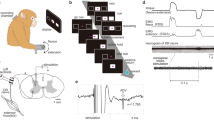Abstract
DURING normal voluntary muscle contractions, the pattern of discharge of a single motoneurone is determined by the summed effects of an enormous variety of different types of synaptic input. In principle, the effect of any one of these inputs could be determined by constructing a histogram of the time of occurrence of motoneurone spikes after repeated presentation of a suitably controlled stimulus1,2. This procedure extracts from the naturally occurring spike train only those changes in firing time locked to the stimulus. The synaptic effect of a given input is thus revealed in terms of the specific contribution it makes to the total firing pattern of the cell. Such studies are most conveniently carried out in man where the cooperation of the subject is invaluable. This report describes an example of this approach in the study of the synaptic effects of a simple cutaneous input. In more general terms, the experimental situation described enables, for the first time, the synaptic connections of single motoneurones to be examined in man, studies previously only attempted in anaesthetised or decerebrate animals.
This is a preview of subscription content, access via your institution
Access options
Subscribe to this journal
Receive 51 print issues and online access
$199.00 per year
only $3.90 per issue
Buy this article
- Purchase on Springer Link
- Instant access to full article PDF
Prices may be subject to local taxes which are calculated during checkout
Similar content being viewed by others
References
Moore, G. P., Perkel, D. H., and Segundo, J. P., A. Rev. Physiol., 28, 493–522 (1966).
Perkel, D. H., Gerstein, G. L., and Moore, G. P., Biophys. J., 7, 391–418 (1967).
Milner-Brown, H. S., Stein, R. B., and Yemm, R., J. Physiol., Lond., 228, 285–306 (1973).
Stephens, J. A., and Usherwood, T. P., J. Physiol., Lond., 250, 37–38P (1975).
Stephens, J. A., and Usherwood, T. P., J. Physiol., Lond., 258, 49P–51P (1976).
Caccia, M. R., McComas, A. J., Upton, A. R. M., and Blogg, T., J. Neur. Neurosurg. Psychiat., 30, 960–977 (1973).
Godaux, E., and Desmedt, J. E., Brain Res., 85, 447–458 (1975).
Marsden, C. D., Merton, P. A., and Morton, H. B., Nature, 238, 140–143 (1972).
Burke, R. E., in New Developments in Electromyography and Clinical Neurophysiology, 3 (edit. by John E. Desmedt), 69–94 (Karger, Berlin, 1973).
Burke, R. E., Rymer, W. Z., and Walsh, J. V., in Control of Posture and Locomotion (edit. by Stein, R. B., Pearson, K. G., Smith, R. S., and Redford, J. B.), 29–44 (Plenum, London, 1973).
Author information
Authors and Affiliations
Rights and permissions
About this article
Cite this article
STEPHENS, J., USHERWOOD, T. & GARNETT, R. Technique for studying synaptic connections of single motoneurones in man. Nature 263, 343–344 (1976). https://doi.org/10.1038/263343a0
Received:
Accepted:
Issue Date:
DOI: https://doi.org/10.1038/263343a0
This article is cited by
-
Mimicking human neuronal pathways in silico: an emergent model on the effective connectivity
Journal of Computational Neuroscience (2014)
-
Responses of human soleus motor units to low-threshold stimulation of the tibial nerve
Experimental Brain Research (2011)
-
Computer simulation study of the relationship between the profile of excitatory postsynaptic potential and stimulus-correlated motoneuron firing
Biological Cybernetics (2009)
-
A spinal pathway between synergists can modulate activity in human elbow flexor muscles
Experimental Brain Research (2008)
-
Recurrence quantification analysis of surface EMG detects changes in motor unit synchronization induced by recurrent inhibition
Experimental Brain Research (2007)
Comments
By submitting a comment you agree to abide by our Terms and Community Guidelines. If you find something abusive or that does not comply with our terms or guidelines please flag it as inappropriate.



